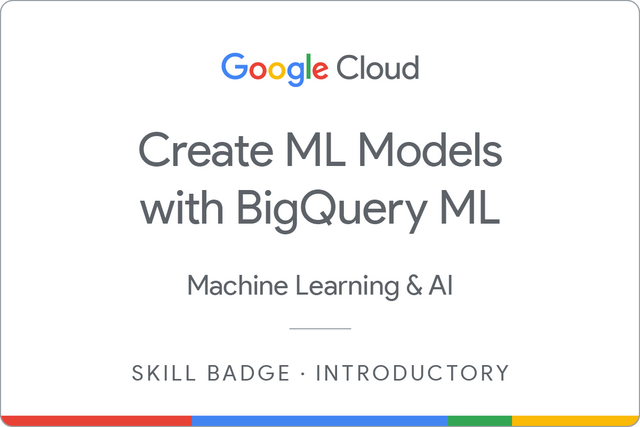Time: 1 hour 30 minutes
Difficulty: Intermediate
Price: 7 Credits
Quest: Create ML Models with BigQuery ML
Last updated: May 20, 2023
You have started a new role as a junior member of the Data Science department Jooli Inc. Your team is working on a number of machine learning initiatives related to urban mobility services. You are expected to help with the development and assessment of data sets and machine learning models to help provide insights based on real work data sets.
You are expected to have the skills and knowledge for these tasks, so don't expect step-by-step guides to be provided.
One of the projects you are working on needs to provide analysis based on real world data that will help in the selection of new bicycle models for public bike share systems. Your role in this project is to develop and evaluate machine learning models that can predict average trip durations for bike schemes using the public data from Austin's public bike share scheme to train and evaluate your models.
Two of the senior data scientists in your team have different theories on what factors are important in determining the duration of a bike share trip and you have been asked to prioritise these to start. The first data scientist maintains that the key factors are the start station, the location of the start station, the day of the week and the hour the trip started. While the second data scientist argues that this is an over complication and the key factors are simply start station, subscriber type, and the hour the trip started.
You have been asked to develop a machine learning model based on each of these input features. Given the fact that stay-at-home orders were in place for Austin during parts of 2021 as a result of COVID-19 you will be working on data from previous years. You have been instructed to train your models on data from Training Year and then evaluate them against data from Evaluation Year on the basis of Mean Absolute Error and the square root of Mean Squared Error.
You can access the public data for the Austin bike share scheme in your project by opening this link to the Austin bike share dataset in the browser tab for your lab.
As a final step you must create and run a query that uses the model that includes subscriber type as a feature, to predict the average trip duration for all trips from the busiest bike sharing station in Evaluation Year (based on the number of trips per station in Evaluation Year) where the subscriber type is 'Single Trip'.
gcloud auth list
gcloud config list project- Create a new dataset in which you can store your machine learning models.
Go to your cloud shell and run the following command to create the model:
bq mk austin- Create the first machine learning model to predict the trip duration for bike trips.
The features of this model must incorporate the starting station name, the hour the trip started, the weekday of the trip, and the address of the start station labeled as location. You must use Training Year data only to train this model.
Go to BigQuery to make the first model and run the following query:
Replace <****Training_Year****> with the year you are using for training.
The year in your lab variable looks like this:
CREATE OR REPLACE MODEL austin.location_model
OPTIONS
(model_type='linear_reg', labels=['duration_minutes']) AS
SELECT
start_station_name,
EXTRACT(HOUR FROM start_time) AS start_hour,
EXTRACT(DAYOFWEEK FROM start_time) AS day_of_week,
duration_minutes,
address as location
FROM
`bigquery-public-data.austin_bikeshare.bikeshare_trips` AS trips
JOIN
`bigquery-public-data.austin_bikeshare.bikeshare_stations` AS stations
ON
trips.start_station_name = stations.name
WHERE
EXTRACT(YEAR FROM start_time) = <****Training_Year****>
AND duration_minutes > 0- Create the second machine learning model to predict the trip duration for bike trips.
The features of this model must incorporate the starting station name, the bike share subscriber type and the start time for the trip. You must also use Training Year data only to train this model.
Go to BigQuery to make the second model and run the following query:
Replace <****Training_Year****> with the year you are using for training.
CREATE OR REPLACE MODEL austin.subscriber_model
OPTIONS
(model_type='linear_reg', labels=['duration_minutes']) AS
SELECT
start_station_name,
EXTRACT(HOUR FROM start_time) AS start_hour,
subscriber_type,
duration_minutes
FROM `bigquery-public-data.austin_bikeshare.bikeshare_trips` AS trips
WHERE EXTRACT(YEAR FROM start_time) = <****Training_Year****>- Evaluate each of the machine learning models against
Evaluation Yeardata only using separate queries.
Your queries must report both the Mean Absolute Error and the Root Mean Square Error.
Go to BigQuery and run the following query:
Replace <****Evaluation_Year****> with the year you are using for evaluating.
SELECT
SQRT(mean_squared_error) AS rmse,
mean_absolute_error
FROM
ML.EVALUATE(MODEL austin.location_model, (
SELECT
start_station_name,
EXTRACT(HOUR FROM start_time) AS start_hour,
EXTRACT(DAYOFWEEK FROM start_time) AS day_of_week,
duration_minutes,
address as location
FROM
`bigquery-public-data.austin_bikeshare.bikeshare_trips` AS trips
JOIN
`bigquery-public-data.austin_bikeshare.bikeshare_stations` AS stations
ON
trips.start_station_name = stations.name
WHERE EXTRACT(YEAR FROM start_time) = <****Evaluation_Year****> )
)SELECT
SQRT(mean_squared_error) AS rmse,
mean_absolute_error
FROM
ML.EVALUATE(MODEL austin.subscriber_model, (
SELECT
start_station_name,
EXTRACT(HOUR FROM start_time) AS start_hour,
subscriber_type,
duration_minutes
FROM
`bigquery-public-data.austin_bikeshare.bikeshare_trips` AS trips
WHERE
EXTRACT(YEAR FROM start_time) = <****Evaluation_Year****>)
)- When both models have been created and evaluated, use the second model, that uses
subscriber_typeas a feature, to predict average trip length for trips from the busiest bike sharing station inEvaluation Yearwhere the subscriber type isSingle Trip.
Go to BigQuery and run the following query:
Replace <****Evaluation_Year****> with the year you are using for evaluating.
SELECT
start_station_name,
COUNT(*) AS trips
FROM
`bigquery-public-data.austin_bikeshare.bikeshare_trips`
WHERE
EXTRACT(YEAR FROM start_time) = <****Evaluation_Year****>
GROUP BY
start_station_name
ORDER BY
trips DESCSELECT AVG(predicted_duration_minutes) AS average_predicted_trip_length
FROM ML.predict(MODEL austin.subscriber_model, (
SELECT
start_station_name,
EXTRACT(HOUR FROM start_time) AS start_hour,
subscriber_type,
duration_minutes
FROM
`bigquery-public-data.austin_bikeshare.bikeshare_trips`
WHERE
EXTRACT(YEAR FROM start_time) = <****Evaluation_Year****>
AND subscriber_type = 'Single Trip'
AND start_station_name = '21st & Speedway @PCL'))

